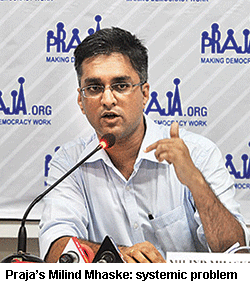 The municipal corporation of Greater Mumbai (MCGM) — the richest local government institution in the country (2017-18 budget: Rs.25,138.91 crore) — has failed to arrest the steady exodus of children from its 1,000-plus primary schools. Over the years, MCGM’s free-of-charge schools, essentially for bottom-of-pyramid households, have become infamous for ill-conceived government interventions, teacher absenteeism and poor learning outcomes. The number of children enroled in them declined from 383,000 in 2015-16 to 343,000 in 2016-17.
The municipal corporation of Greater Mumbai (MCGM) — the richest local government institution in the country (2017-18 budget: Rs.25,138.91 crore) — has failed to arrest the steady exodus of children from its 1,000-plus primary schools. Over the years, MCGM’s free-of-charge schools, essentially for bottom-of-pyramid households, have become infamous for ill-conceived government interventions, teacher absenteeism and poor learning outcomes. The number of children enroled in them declined from 383,000 in 2015-16 to 343,000 in 2016-17.
Released last month The State of Municipal Schools in Mumbai, a report published by the Praja Foundation, a Mumbai-based NGO, using data obtained under the Right to Information Act, 2005, highlights that the number of students who applied for admission in class I of MCGM schools declined to 32,218 in 2016-17 from 34,549 the previous year.
MCGM owns 1,082 primary (class I-VIII) and 148 secondary (class IX-X) schools which provide free-of-charge education to children from low-income households in seven languages — Marathi, Gujarati, Hindi, Kannada, Tamil, Telugu, Urdu and English. Over the years, unlike the corporation’s English-medium schools, all of MCGM’s vernacular medium schools have witnessed declining enrolments to the extent that the civic body was forced to shut 35 vernacular medium primaries in September 2016 due to zero enrolments in class I. Student enrolments in Marathi (the state’s official language)-medium schools also fell from 71,454 in 2015-16 to 62,692 in 2016-17. Simultaneously, enrolment in English-medium schools rose from 71,266 students in 2015-16 to 74,035 in 2016-17, indicating growing demand for English-medium schools even in lowest-income households.
“The civic body spends between Rs.44,394 (2016-17) to Rs.52,142 (allocated for 2017-18) per year per student, which is substantially more than the per capita expenditure of budget private schools. If despite this, MCGM schools are unable to reduce student attrition, there is a systemic problem that needs to be addressed,” says Milind Mhaske, Praja’s project director.
While MCGM officials blame the growing aversion to vernacular medium schools and parents’ high preference for private English-medium schools which are obliged to reserve 25 percent of capacity in class I for low-income children in their neighbourhoods, Praja’s survey of 2,767 households indicates poor learning outcomes in all corporation schools is the prime factor which prompts parents to move their progeny from free-of-charge MCGM schools into fees-levying private budget schools, many of them unrecognised and violative of RTE infrastructure norms.
A comparison of the total percentage of MCGM students versus private schools passing the class X school-leaving exam of the Maharashtra State Board of Secondary and Higher Secondary Education indicates that only 69 percent of corporation school students passed the March 2017 board exams as against 92 percent of private schools.
Even as MCGM is somewhat over-ambitiously drawing up a plan to introduce “international curriculum” in 25 of its schools to stem student dropouts and school closures, education is low priority for the maximum city’s 227 municipal councillors. According to the foundation’s report, questions relating to closure of MCGM’s schools and high student drop-out rates were raised only once in the corporation’s debates, while questions pertaining to naming and renaming of schools were raised ten times during 2016-2017. While the MCGM bureaucracy blames poor learning outcomes in corporation schools on teachers, educationists believe that the root cause is the political indifference of MLAs (members of the legislative assembly) and municipal councillors to poor early childhood education of children from bottom-of-pyramid households. They are yet to grasp the reality that throwing money at a problem won’t make it go away.
Dipta Joshi (Mumbai)